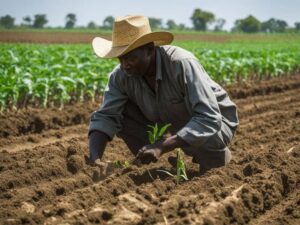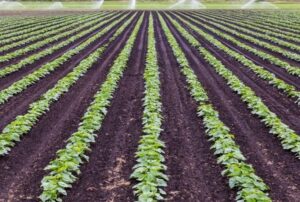5 Ways Variable Rate Technology Is Transforming Agriculture
Precision agriculture relies heavily on technology to help farmers manage field variability with precision. Variable rate technology plays a key role in this shift. By providing real-time data on soil composition, moisture levels, and crop health, VRT allows farmers to make data-driven decisions about where and how much to apply certain inputs.
How Does Variable Rate Technology Work?

At its core, VRT uses GPS and sensors to monitor various factors in the field, such as soil pH, moisture content, and nutrient levels. This data is then analyzed and processed to create maps that inform farmers about the specific needs of different areas within the field. Based on this information, the system adjusts the rate of input application, ensuring that resources are used where they are most needed.
For instance, variable rate application of fertilizers can ensure that high-nutrient areas of a field receive the appropriate amount of fertilizer, while low-nutrient areas receive a different amount. This leads to more efficient use of resources and ultimately higher yields.
Benefits for Farmers
By utilizing VRT in precision agriculture, farmers can:
- Reduce input costs by applying fertilizers, water, and pesticides only where needed.
- Enhance crop yield by providing plants with the ideal amount of nutrients and water.
- Minimize environmental impact by reducing excess application of chemicals and fertilizers, which can lead to runoff and pollution.
Incorporating variable rate technology into daily farming practices not only improves the economic efficiency of farms but also contributes to sustainable agriculture.
2. Improved Crop Management and Yield Maximization

The advent of VRT has significantly improved crop management. Variable rate technology enables farmers to customize input usage on a per-plant basis. This level of customization maximizes yield by ensuring that crops receive exactly what they need at the right time.
VRT and Yield Mapping
One of the most crucial applications of variable rate technology is in the creation of yield maps. These maps provide farmers with a detailed view of crop performance across different sections of a field. With VRT, this information allows for the precise adjustment of inputs such as fertilizers, irrigation, and even seed planting patterns.
Real-World Example of Yield Improvement
For example, a wheat farm can use VRT to apply nitrogen at different rates across the field. Areas with higher organic matter and better soil conditions may need less nitrogen, while poorer areas may require more. By using variable rate application methods, farmers can optimize nutrient application, leading to higher-quality wheat crops and increased overall yield.
Long-Term Benefits for Crop Production
In the long term, VRT in precision agriculture helps improve soil health by preventing over-application of chemicals and promoting the use of organic farming techniques. These practices align with sustainable agriculture goals by reducing dependency on synthetic fertilizers and pesticides. Over time, this leads to healthier soil and more productive farms.
3. Cost Reduction Through Efficient Resource Use

One of the primary advantages of variable rate technology is its ability to reduce costs for farmers. By applying inputs only where they are needed, VRT helps farmers avoid unnecessary expenditure on resources that may otherwise go to waste.
How VRT Cuts Costs
- Fertilizer Savings: By using variable rate application, farmers apply fertilizers more accurately and only in areas that require them. This not only saves money on fertilizers but also reduces the environmental impact of excess chemical runoff.
- Water Efficiency: VRT also allows for more efficient irrigation. Farmers can use moisture sensors and soil maps to determine the exact water requirements of each part of the field, thus minimizing water waste.
- Pesticide Reduction: Variable rate technology allows farmers to target pests more precisely, reducing the need for blanket pesticide applications.
Practical Example of Cost Savings
Let’s say a farmer uses VRT to apply a fertilizer blend across a 100-acre field. By identifying areas with richer soil and reducing fertilizer use in these spots, the farmer can save a significant amount of money. Similarly, by applying pesticides only to affected areas, farmers save on labor and pesticide costs.
By optimizing resources, VRT in precision agriculture helps farmers lower operational costs and increase their profitability.
4. Environmental Benefits and Sustainable Agriculture

As the agricultural industry continues to face growing concerns over environmental impact, variable rate technology offers an innovative solution. With its ability to optimize the use of water, fertilizers, and pesticides, VRT helps reduce waste and minimize negative environmental effects.
VRT and Reduced Environmental Footprint
- Lower Chemical Runoff: By applying fertilizers and pesticides precisely where needed, VRT reduces the likelihood of runoff into nearby water sources, which can contribute to water pollution.
- Soil Preservation: VRT encourages soil conservation by preventing over-farming and overuse of chemical inputs. Farmers can use variable rate technology to apply organic farming practices and reduce soil degradation.
- Water Conservation: Water is one of the most precious resources in agriculture. With VRT, farmers can implement drip irrigation or other water-saving technologies that apply water only to areas that require it, significantly reducing water waste.
Real-World Impact on Sustainability
In sustainable farming systems, variable rate technology has a vital role in reducing the ecological footprint of agricultural activities. For example, a farmer practicing organic methods can use VRT to apply compost and organic fertilizers more efficiently, ensuring that inputs are used sparingly and precisely.
By focusing on sustainability, vrt full form in agriculture becomes a tool for both economic and ecological balance, driving long-term viability for farms.
5. Data-Driven Decisions and Enhanced Farm Management

The ability to make informed, data-driven decisions is one of the greatest benefits of variable rate technology. With the help of sensors, GPS, and mapping software, farmers can collect and analyze vast amounts of data about their fields, enabling them to optimize every aspect of farm management.
Advanced Data Analytics in Agriculture
Farmers use VRT to monitor soil moisture, nutrient levels, and crop health throughout the growing season. By continuously collecting data, farmers can adjust their approach to farming based on real-time conditions. For instance, if a section of the field is drying out faster than expected, variable rate technology can help the farmer apply more water to that area.
Integrating VRT with Farm Management Software
Farm management software that integrates VRT allows farmers to streamline their operations. These tools can provide actionable insights on everything from planting schedules to harvest times, further enhancing efficiency.
Practical Example of Data-Driven Farm Management
Imagine a farmer growing corn using vrt in precision agriculture. With a series of soil sensors and GPS-guided machinery, they can analyze data such as soil temperature, pH levels, and moisture content. Based on this data, they can make informed decisions about irrigation schedules, fertilizer applications, and pest control.
By using variable rate technology to collect and analyze data, farmers can boost efficiency, increase profitability, and ensure better resource management.
Conclusion
Variable rate technology (VRT) is a game-changer in modern agriculture. In 2025, it continues to transform the way farmers approach crop production, irrigation, fertilization, and pest control. By using VRT in precision agriculture, farmers can reduce costs, increase yields, and promote sustainable farming practices.
With the ability to make data-driven decisions, optimize resource usage, and minimize environmental impact, VRT is not just a trend but a crucial tool for the future of farming. As technology continues to advance, we can expect even more innovative applications of variable rate technology to emerge, further revolutionizing the agriculture industry.
For more insights into precision agriculture and variable rate technology, check out our other blog posts:
- Rabi Seed Information, Timing, Cultivation, and Cultivation Methods
- Advanced Technology Trends in Modern Farming
- The Importance of Pulse Crops in Sustainable Agriculture
By integrating variable rate technology into your farming practices, you can ensure that your farm remains efficient, profitable, and environmentally friendly in the years to come.














Post Comment